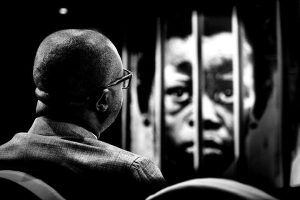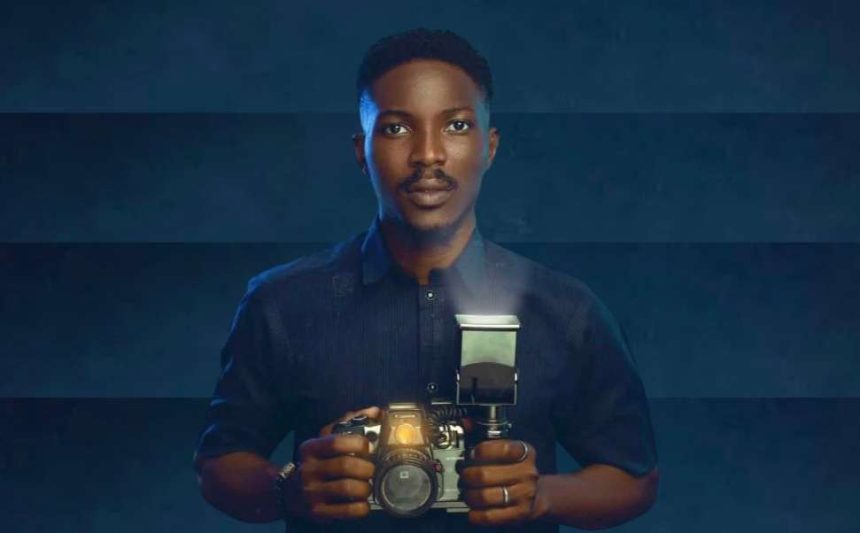In the world of political communication, where a single image can shape public perception and define legacy, one man has emerged as a visual historian of Nigerian leadership. And that man is Omotayo Adeniyi.
But Omotayo Adeniyi is not just any photographer. His lens doesn’t just capture, it tells stories that connect citizens to power, and humanity to governance.
From humble beginnings in a digital studio in Ile-Ife to becoming the personal photographer to Nigeria’s Minister of Interior, his journey is one marked by grit, self-mastery, and the quiet force of grace.
In a recent Media Masterclass for serving PROs of various para-military agencies where Tayo facilitated a session on the use of photography as a storytelling tool, the Interior Minister, Hon. (Dr.) Olubunmi Tunji-Ojo, described him as the best photographer out there.
“Tayo is the best photographer that I have ever seen. Thank you, Tayo. I love your shots,” the minister commended.
In this exclusive interview with Techparley Africa’s Quadri Adejumo, Omotayo shares his journey and how his photography storytelling skill has pushed him beyond his imaginations.
The Making of a Master Lensman
In late 2008, Omotayo Adeniyi began his creative career not as a photographer, but as a photo editor and graphic designer at Klicks Digital Studios in Ile-Ife. Klicks, he says, was where he sharpened his eye for detail and developed a drive for knowledge.
“My journey into the world of photography began humbly in late 2008, not as a photographer but as a photo editor and graphics designer at Klicks Digital Studios, Ile-Ife, Osun State. That studio became my training ground, something I love to describe as my unofficial school of photography, he tells Techparley Africa.
“While others were sleeping, I spent countless nights poring over photography books and online tutorials. I was hungry to understand not just how to take pictures, but how to tell stories through them.
“Looking back, I owe a great deal to those who helped shape me in those early years. People like Mr. Deji Adepetu (fondly known as DJ). That’s my mentor and boss.
“Also, Mr. Blessing Adeniyi, who is my elder brother, anyway. But he has been a constant support. He is a legendary videographer. He is the mastermind behind some of Nigeria’s best musical videos.
“Quite a number of people have shaped me, in all honesty. Back in Klicks, those egbon(s) challenged and inspired me to do better, and I am eternally grateful.”
By 2011, Omotayo had stepped away from studio work to pursue freelance editing. His trajectory soon led him to a leadership role, managing KOST Photography Studios in Ile-Ife for nearly two years.
“In 2011, I stepped away from the studio to work as a freelance editor, where I was collaborating with photographers both within and beyond Osun State.
“It was during this phase that I also took on a managerial role, overseeing the setup and day-to-day running of KOST Photography Studios in Ile-Ife for nearly two years.
“These experiences gave me the confidence and clarity to finally launch my own brand in 2016, focusing on event coverage, portraiture, and cinematography.
“2018 marked a major turning point. That year, I opened my own photography studio in Ile-Ife. But soon after, I moved to Abuja in search of new inspiration and broader opportunities.
“As God will have it, that same year, I attended the Abuja Photo Festival, which opened my eyes to a new world of documentary photography. Love at first sight. It was a calling I could not ignore.
From Cultural Roots to Political Power
A major breakthrough came in 2021. Omotayo was commissioned by Senator Saliu Mustapha to document traditional clay pot making and the transformation of Ile-Kewu, an Arabic school, into a modern mosque in Kwara State.
That project, he says, rich in culture and symbolism, became a stepping stone.
“The project not only reignited my passion for cultural storytelling,” he says. “But it also earned me the trust to become the Senator’s personal campaign photographer.”
In 2022, his reputation earned him a recommendation to serve as the personal photographer to Senator Gbemisola Saraki, then Minister of State for Mines and Steel Development.
“In 2022, thanks to a recommendation by Mr. Kunle Oniyangi, I was appointed the personal photographer to Senator Gbemisola Saraki, the Minister of State for Mines and Steel Development during the FPMB administration.
Though my time in that office was short-lived, it was impactful. We served until May 29, 2023.”
In August 2023, then came another referral, this time to Hon. (Dr.) Olubunmi Tunji-Ojo, the current Minister of Interior. It would prove transformative.
Shortly after my job with Senator Gbemisola, in August 2023, I got another recommendation, this time from Mr. Obanijesu (OBJ).
“He connected me with Mr Babatunde Alao, the Special Adviser on Media and Publicity to Hon. (Dr.) Olubunmi Tunji-Ojo. And, since then, it has been a major shift in my career, especially around political and governmental photography.
Inside the Optics of Power
Now working at the heart of Nigeria’s Ministry of Interior, Omotayo captures more than cabinet meetings and inspection tours. His lens seeks humanity amid hierarchy.
“When I’m behind the lens, especially in political spaces, I’m not just capturing a person,” he explains. “I’m capturing a moment that could become history. So, I focus on the human side of leadership. What do I mean? The expressions, the tension, the calm, and the unspoken emotions.”
“Before a shot, I study the subject and the setting. I pay attention to lighting of the space, body language, and interactions. In photography, what you think is a small moment can eventually tell a big story.”
But the most difficult task? Choosing which images to release.
“The hardest part comes after the shoot, to be honest. How do you choose which photo to publish, keep or kill. In photography, every shot has value,” he says.
“But before the general public can consume them, I have to sit back before the screen to pick the ones that carry truth and emotion of the occasion.
“As the chief gatekeeper of his photos, my goal is to make people feel something by way of seeing beyond the surface and connecting with the story inside the frame.”
A Frame of Humanity
According to Omotayo, among his extensive archive, one image stands out. It was during a stakeholder session where the Minister reviewed a PRAWA report on the situation of children and young adults deprived of liberty in Nigeria. On screen: a photo of a young child behind bars. In the room: silence.

“The way the Minister looked at that child, there was empathy in his eyes, a kind of silent pain that said more than words ever could,” Omotayo recalls. “For me, as a lens guy, that single frame told a story of leadership, humanity, and the reality of our system.”
“That day, he was seated, quietly observing the image as displayed on the screen. The image alone was emotional. The Minister’s posture and continence then added to the message.
“Let me quickly say that a lot of people have come to think the Minister’s achievements only revolve around the Nigeria Immigration Service (NIS). That’s quite untrue.
“Only if they know how much he has invested across all other agencies including the Correctional Service. But, again, our work is around security, and not everything can be shared publicly.
“Back to the image, it wasn’t a posed moment for the Minister. It was raw and honest. And the child’s expression… it held a mix of innocence and confinement that hit deep.
“For me, it’s a photo I treasure as it wasn’t just another photo. In essence, it was a moment of truth and a reminder of why I do what I do.”
The Role of Visual Trust in Governance
Omotayo’s work underscores a powerful truth: in a digital age flooded with manipulated content, authentic visuals can build real connections between citizens and the state.
“In a time when perception shapes reality, visual storytelling plays a powerful role in building public trust,” he notes.
“A single honest image of a leader listening, showing empathy, or simply being human, can connect people to those in power. It bridges the gap between authority and the everyday citizen.”
Beyond the Frame
Working closely with Dr. Olubunmi Tunji-Ojo has not only expanded Omotayo’s portfolio, it’s also transformed him.
“With the Honourable Minister of Interior, everyday is a new day to learn. He is a superb teacher. And, I have learnt to many things around corporate leadership, project management, cyber security and Internet of Things (IoT).
“In the media team, we use to joke about the fact that we are all due for a honourary diploma in any of these concentrations just by the sheer luck of being around him.
“Oga is good. We need him to be cloned, and distributed across multiple ministries, and international development organisations.”
More than a personal success story, Omotayo Adeniyi’s career represents a growing recognition of the photographer not just as a technician, but as a national memory-keeper.
“I’m still learning, still evolving —and still deeply committed to using photography not just to capture moments, but to preserve history and amplify stories that matter.”
Indeed, in the lens of Omotayo Adeniyi, power is more than politics. It is presence, it is empathy, and above all, it is truth.





